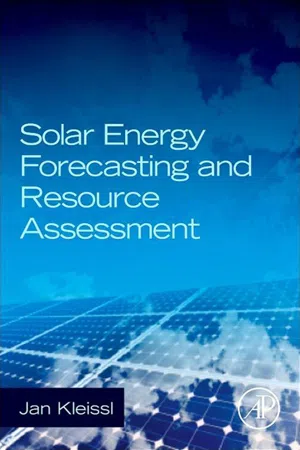
- 462 pages
- English
- ePUB (mobile friendly)
- Available on iOS & Android
Solar Energy Forecasting and Resource Assessment
About This Book
Solar Energy Forecasting and Resource Assessment is a vital text for solar energy professionals, addressing a critical gap in the core literature of the field. As major barriers to solar energy implementation, such as materials cost and low conversion efficiency, continue to fall, issues of intermittency and reliability have come to the fore. Scrutiny from solar project developers and their financiers on the accuracy of long-term resource projections and grid operators' concerns about variable short-term power generation have made the field of solar forecasting and resource assessment pivotally important. This volume provides an authoritative voice on the topic, incorporating contributions from an internationally recognized group of top authors from both industry and academia, focused on providing information from underlying scientific fundamentals to practical applications and emphasizing the latest technological developments driving this discipline forward.
- The only reference dedicated to forecasting and assessing solar resources enables a complete understanding of the state of the art from the world's most renowned experts.
- Demonstrates how to derive reliable data on solar resource availability and variability at specific locations to support accurate prediction of solar plant performance and attendant financial analysis.
- Provides cutting-edge information on recent advances in solar forecasting through monitoring, satellite and ground remote sensing, and numerical weather prediction.
Frequently asked questions
Information
Terms and Definitions
1.1 Introduction
1.2 Overview of Solar-Power Conversion Technologies
1.2.1 Photovoltaic



Table of contents
- Cover image
- Title page
- Table of Contents
- Copyright
- Preface
- Biography
- Chapter 1. Terms and Definitions
- Chapter 2. Semi-Empirical Satellite Models
- Chapter 3. Physically Based Satellite Methods
- Chapter 4. Evaluation of Resource Risk in Solar-Project Financing
- Chapter 5. Bankable Solar-Radiation Datasets
- Chapter 6. Solar Resource Variability
- Chapter 7. Quantifying and Simulating Solar-Plant Variability Using Irradiance Data
- Chapter 8. Overview of Solar-Forecasting Methods and a Metric for Accuracy Evaluation
- Chapter 9. Sky-Imaging Systems for Short-Term Forecasting
- Chapter 10. SolarAnywhere Forecasting
- Chapter 11. Satellite-Based Irradiance and Power Forecasting for the German Energy Market
- Chapter 12. Forecasting Solar Irradiance with Numerical Weather Prediction Models
- Chapter 13. Data Assimilation in Numerical Weather Prediction and Sample Applications
- Chapter 14. Case Studies of Solar Forecasting with the Weather Research and Forecasting Model at GL-Garrad Hassan
- Chapter 15. Stochastic-Learning Methods
- Color Plates
- Index